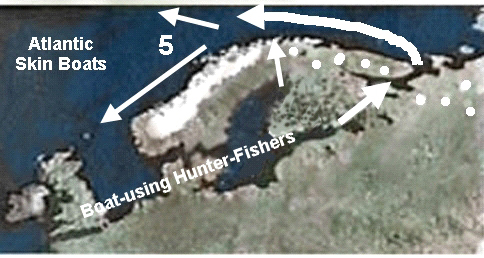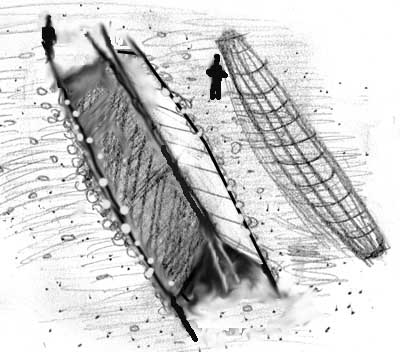3. EXPANSIONS
TO ARCTIC AND NORTH ATLANTIC SEAS
THE
DEVELOPMENT OF SEAGOING SKIN BOATS AND EXPANSION TO THE ARCTIC
6,000-4,000BP
Synopsis:
The boat peoples that emerged in the lands released from the grip of
the glaciers did not expand just to the east to the Ural Mountains
and beyond to the Ob River basin, but also towards the north. The
land was so water-filled that it was possible to travel easily by boat
to the White Sea. The peoples who did so were obviously descended from
the archeological "Kunda Culture" originally established up the east
coast of the swollen Baltic Sea, which extended up into Finland. The
artifacts from the Kunda Culture offered not just stone adzes for
making dugouts, but also large harpoons suggesting these people had
learned how to go out into the sea and hunt sea mammals like seals.
Naturally such people, being accustomed now to hunting in the open
seas, would be more interested in expanding into further open sea, than
returning to marshes and lakes. This produced a branch of the Kunda
Culture that reached the White Sea and from there continued west to the
bountiful waters of arctic Norway, warmed by the Gulf Stream reaching
there. And from there the seagoing boat culture spread around the
arctic ocean and south along the ocean coasts, possibly following whale
migrations
Introduction: The Boat
People Second Branch - North to the Arctic Ocean
MIGRATIONS TO ARCTIC NORWAY
The Kunda Culture, already discussed earlier, along
with the Maglemose Culture, not only expanded east as far as the Urals,
but also branched northward. In this article we will present the quite
amazing story of expansion from the prehistoric Baltic Sea to Lake
Onega, then White Sea, then arctic
Norway facilitated by the invention of the skin boat because trees
large enough for seagoing dugouts were not available.
The following archeological map of cultures was
presented earlier. It shows how archeologists have categorized the
artifacts they have unearthed and the locations they were found.
Figure
1
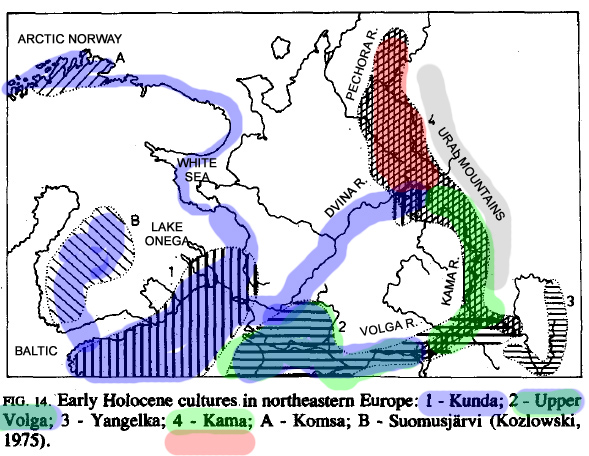 This map, with colour added on top of
a map of archeological investigation in the paper by Kozlowski J, and
Bandi H-G 1984 shows in blue the manner in which the "Kunda" culture
which had seagoing experience, expanded not just to the Urals via the
Dvina, and perhaps via the Voga, but also expanded north to the White
Sea. The other cultures may have had a more direct contribution from
the "Maglemose" culture. Since material culture is changed only by
environmental circumstances, it is likely that in terms of soft culture
(world-view, folklore, and language) the "Maglemose" culture of the
south Baltic and the "Kunda" culture in the north were probably the
same since all the boat peoples covered vast territories and that kept
a uniformity in the soft culture..
This map, with colour added on top of
a map of archeological investigation in the paper by Kozlowski J, and
Bandi H-G 1984 shows in blue the manner in which the "Kunda" culture
which had seagoing experience, expanded not just to the Urals via the
Dvina, and perhaps via the Voga, but also expanded north to the White
Sea. The other cultures may have had a more direct contribution from
the "Maglemose" culture. Since material culture is changed only by
environmental circumstances, it is likely that in terms of soft culture
(world-view, folklore, and language) the "Maglemose" culture of the
south Baltic and the "Kunda" culture in the north were probably the
same since all the boat peoples covered vast territories and that kept
a uniformity in the soft culture..
In terms of the story of the expansion of the Kunda
Culture into the arctic, the relevant culture is the one at the top of
Norway, the Komsa Culture.
As we will see below, they must have arisen
from the practice of the Kunda Culture descendants at Lake Onega from
making annual journeys to the White Sea and further, to harvest the
waters of arctic Norway, warmed by the Gulf Stream (or "North Atlantic
Drift") As we will see, rock carvings show the same skin boat
with moose-head prow at the Norwegian arctic coast as in rock carvings
at the White Sea and at Lake Onega south of the White Sea. The Komsa
Culture was the intermediate step between people at Lake Onega who
travelled
to the arctic only for the summer and then returned in winter, and
becoming permanent residents of the arctic, staying there through the
dark winter. This step was marked by changing the material for skin
boats from moose hide to walrus hide.
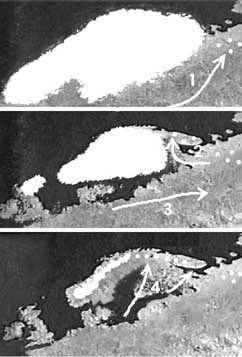
Figure 2
A sequence of maps, offered earlier, showing (1) how originally there
were European tundra reindeer peoples travelling north south hunting
reindeer.
The second map shows the expansion of boat peoples (3) and and
eventually reindeer peoples (2) migrating into northern Finland. These
reindeer people were not the original European reindeer people but
reindeer people with mongoloid traits from Asia. The third map shows
continued northward expansion of boat peoples into the north to pursue
the bountiful waterlife in the waters of arctic Norway. The map below
summarizes the continued expansion of the seagoing boat people who
should be speaking the "Kunda" language
Rock carvings found at the Norwegian island of Sørøya, show
images of a light dugout, too small for ocean waves, but also a
high-prowed vessel with a moose-head prow These people obviousy
also had dugouts, but, like the Hanti dugouts of today, were too small
to
navigate in open seas. Possibly the Inuit kayak , which enclosed the
top to allow waves to break over the top, was in effect an adaptation
of the tiny one-person northern dugout, to deal with high waves and
these could be built without need for any tree.
These details practically prove their utlimate Kunda
Culture origins.for the peoples who visited arctic Norway,
Thus to be correct, the map should show the Kunda
Culture extending north from Lake Onega to the White Sea and then west
to arctic Norway, as suggested by the blue overlay in Figure 1.
While some archeologists have suggested the Komsa
people and others who left rock carvings on arctic islands, came up the
Norwegian coasts, why would they travel north in
ocean waves along a forbidding shore with glaciers? It is possible but
unlikely. Origins from the east, from the White Sea,
is proven from the locations of the rock carvings showing the moosehead
prow skin boats. Furthermore, along the entire way, seahunters will be
invited to continue going from the bounty of sea life towards thge west
from where the Gulf Stream (North Atlantic Drift) came. If one came up
the
Norwegian coast, there would not be much that is exciting until they
got north of the Lofotens, where the regions were affected by the
warmed waters.
The Fosna Culture of the lower Norwegian coast may
have had two origins - the Maglemose culture in southern Norway which
was glacier free already about 12,000 years ago, and of course the skin
boat peoples spreading south from the Norwegian arctic.
The story of the
reindeer and reindeer people is still unclear. On the one hand it is
not clear if any European reindeer people continued a reindeer-oriented
way of life, instead of converting to the Kunda culture when the
tundras disappeared. It is possible that small reindeer hunting groups
in southern Norway may have survived until the glaciers had melted. It
is also possible that some of the reindeer-hunting ancestors of the
Kunda culture managed to remain with some reindeer - IF the arctic
Scandinavian coast was ice-free in time to recieve some reindeer herds
from northern FInland. Otherwise, we are dealing with Asian reindeer
peoples arriving from the east carrying the N1c1 haplogroup and
mongoloid characteristics.
Obviously the arrival of boat peoples in the arctic
waters required the disappearance of glaciers in the seas around
the White Sea. As shown on the maps depicting about 10,000 years
ago, glaciers prevented entry into the White Sea area at that time,
while it was possible to travel to the Urals. Therefore, the expansion
of the Kunda Culture to the White Sea and continuation to the arctic
ocean of Norway, occurred later, possibly reaching arctic Norway only
around 7,000 years ago.
As I said above, eventually some of the
Lake Onega sea-hunters stopped returning south in Fall and remained
permanently in the north. They would have changed to making boats out
of reindeer hide (boats seen in Alta carvings), or walrus hide. Walrus
hide skin boats were used in recent history by the Inuit, therefore, at
some point walrus skins were used, and the Inuit culture may have
arisen from it.
The modern Inuit language offers some remarkable
coincidenced with the modern Finnish and Estonian languages, which
suggests there is a connection between the expansion of Inuit skin boat
culture, and origins in the branch of the "Kunda" culture that expanded
to the White Sea.
"Maglemose" to "Kunda"
Culture: From Marshes to Seas
Archeologists discovered in the early
1900's on a hill (that was originally an island) at Kunda in northeast
Estonia, evidence of a campsite of boat peoples who were obviously
venturing out into the open sea. We know they were dugout users,
because archeologists found large adzes. But their large harpoons
clearly suggested they were hunting large sea animals like seals or
small whales.
Figure
3
From the "Kunda"archeological
finds, the image at right shows a large harpoon and an
adze head -used for hollowing a log for a dugout with the help of fire.
It suggests the Kunda Culture hunted seals and whales and would have
needed large dugouts like the ones unearthed later, which held six men
and a helmsmen
To hunt seals and larger sea animals required
venturing out into the waves of the sea, and that required larger
dugouts with high prows than the original single-man small dugouts for
rivers and marshes. The Kunda culture people had to look for the
largest
trees they could find - giant trees a meter or more in
diameter, for their large dugouts. In Estonia in the last
centuries, large oaks were
celebrated. I think the tradition of celebrating oaks
began millenia ago, when a tribe would identify oaks that looked like
they had potential of becoming very large, and suitable for making into
a large dugout. Since such a tree takes a many generations to grow to
the appropriate size, it was necessary for a tribe to designate such a
tree already many generations ahead of time. Later in history, as the
world turned towards making boats with planks, the purpose of reverence
for trees destined for large dugouts was forgotten. An interesting
sidenote: in recent centuries, large oaks in the Estonian landscape had
names, as if they were people.
But why did the "Maglemose" culture become seagoing
when it expanded up the east Baltic coast. I think it is because of the
prevailing winds. The winds came from the northwest, and large
waves were always crashing onto the east Baltic coasts. While boats
could find calm in the lee of islands, when they crossed waters
roughened by the forces of the prevailing wind, the going was rough. At
the
same time crashing waves produced barren rock islands out in
the sea which could become resting places of herds of seals.
The "Kunda" seagoing dugout of about 10,000BC,
was a successful one, and its users expanded into Lake Lagoda
and Lake Onega too. The land was still depressed from the former weight
of the glaciers, and it was probably possible to ride a boat from
the Baltic Sea area to the White Sea.
It is easy to imagine that once the large dugouts
had developed, then with population growth, the "Kunda" culture tribe
broke
apart from time to time, with a portion leaving the parental
territories in search of new territories of a similar nature in the sea
environment.
Archeology has found the remains of a large dugout
in the Jutland Penisula area too, which shows that the large seagoing
dugout developed elsewhere that the sea offered food opportunities.
This dugout had a place for a torch and
is thought to have been used to harvest eels at night. We cannot tell
if the eel hunters came from the "Kunda" culture, or developed
independently out of the "Maglemose" culture, similarly drawn out into
the sea by opportunities.
Eventually large dugouts were common in the Baltic
Sea everywhere. Archeological finds suggest that the standard
large dugout
of the east Baltic was large enough for three pairs of rowers and one
helmsman, totalling seven men. If the boat had to carry cargo, the
cargo was placed in the middle, and two rowers were removed, leaving
five. Besides archeological finds showing sets of seven oars, it is
interesting that Estonian and Finnish remembers this in
their numerals. (Using the Estonian version) the word for 7 is seitse, but that resonates
with sõiduse 'of the
riding, voyaging' and 5 is viis,
which resonates with viise
'of the carrying'. Because both Estonian and Finnish have it, this must
be many millenia old.
The breakaways from the "Kunda" culture had to
travel to find new territories with the same sea animals. The
seas were higher than they are now (the lands were lower too, not
having rebounded yet from the pressure of the Ice Age glaciers.) and
the Gulf of Finland, Lake Lagoda, Lake Onega, and even White Sea were
interconnected.
We do not know where the sea-hunters went, as it is
difficult to find the traces of highly mobile boat peoples in lands
that were mostly islands in a flooded landscape. The best
evidence comes from carvings made on rocks at Lake Onega, the White
Sea, and in places across arctic Scandinavia.
These migrating tribes had no problem finding the
sea animals. The real problem was in finding trees large enough for
seagoing dugouts. The further north they went the smaller the trees
were. Like today's Hanti or Khanti of the Ob River today. they could
only make small single person
dugouts. Either they had to make long journeys southward to find large
trees to make new seagoing dugouts as the old ones degenerated, or they
had to
find a new way to make boats large enough to handle the waves of the
open sea.
I believe the solution was found in what I would
call the "dugout moose".
Moose are large animals that can cross large bodies
of water, and will do so as long as they can see the opposite side. A
swimming moose would seem like a very large moving log. I believe it
inspired the idea of using a moose carcass to make a boat.
The rock carvings of Lake Onega, north
to the White Sea, and across the European arctic to the coasts of
arctic Norway show a very interesting boat. The simplest and smallest
one shows a moosehead on its prow, and it holds no more than three men.
When comparing the scale of people versus the size of the head on the
prow, it is clear that what they have done is in fact created a "dugout
moose". They had taken a moose carcass, slit it open along its back,
and 'hollowed' it To retain its shape,
they have simply have used
the same principle as the moose itself has to hold its shape -
ribs. It is possible that the earliest and simplest "dugout moose"
retained the moose's own ribcage. I can easily see them using the
moose's own skeleton - adding wood pieces to give it an appropriate
shape. Then they used fire and smoke to dry and preserve the inside.
The
final result is a boat which is a dugout moose mummified and hardened
by drying with fire. The resulting boat offered a very high prow
that could handle high waves.
This introduced the principle of a boat made of a
frame over which a skin of some kind was placed
Figure 4
THE EVOLUTION OF THE
SKIN BOAT FROM THE
"DUGOUT MOOSE"
Theory by Andres Paabo
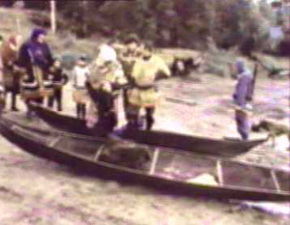 Fig 4A
Fig 4A:
OB RIVER
The concept of the original boat did not involve
frames and skins.
All boats were dugout logs. The dugout is still made by
the Khanti of
the Ob (image at right is from a Lennart Meri film produced in Estonia
in the 80's) However this dugout is small because at the northern edge
of the forest zone, the trees are too small to make large seaworthy
dugouts.
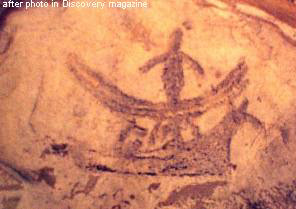 Fig 4B
Fig 4B:
ARCTIC NORWAY
A small dugout like the one of the Khanti is seen in the
top image
in the rock carving from arctic Norway, dated to some 6000 years ago.
But this small dugout was not adequate for dealing with the high waves
of the ocean, The image below it show the skin boat made from moose
hide, the moose head represented on the prow.
Boat people who wanted to harvest the arctic, could not use
the slim dugouts made from the small northern trees. They had to
develop something new. My theory is that it began with someone's idea
of trying to make a dugout from a dead moose carcass.
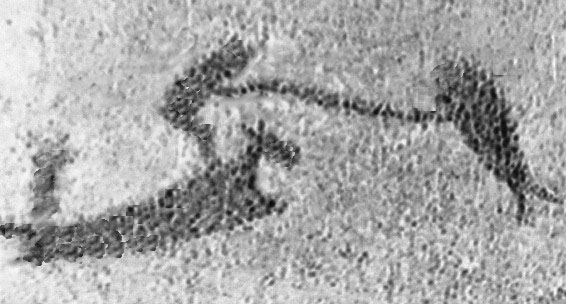 Fig 4C
Fig 4C
LAKE ONEGA ROCK CARVINGS
The
Lake Onega rock carvings present several examples showing the
small
moose skin boat being used in sea-hunting. Allowing for some
variation by the artist, the scale of the moose head is
generally of natural size, when compared with the size of the two or
three people inside.
 Fig 4D-E
Fig 4D-E
THE MOOSE AS A BOAT
All
the
skin-on-frame boats of the world owe their origins to this
beginning, which I believe began with applying the concept of the
dugout to a moose carcass. The idea may have begun with someone seeing
a moose swimming and initially thinking it was a large floating log.
Coming close they discover it is a moose; however the idea of making a
large boat was already planted in their mind and they wondered if a
boat could be made from it. In the beginning the idea of a skin on a
frame did not exist. It was born when the concept of the moose's ribs
was employed to hold the skin in shape.
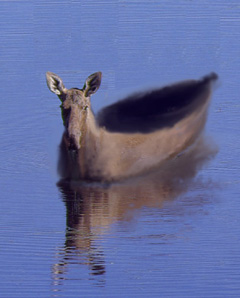 Note that the
moose has a massive body giving a great deal of skin that can
be
stretched to create a boat large enough to hold three men
Note that the
moose has a massive body giving a great deal of skin that can
be
stretched to create a boat large enough to hold three men.
Since the moose (shown above) is a forest
zone animal, the use of the moose meant that its users did not remain
in the arctic, but migrated between the arctic coast and forested
regions. It is interesting that the Lake Onega carvings show
no images of moose with antlers. Since males grow antlers in summer and
shed them in fall, it follows that the Lake Onega people were in the
Lake Onega area only in winter-spring. They then left for the arctic,
perhaps going as far as Alta, and did not experience the moose with
antlers. The Alta rock carvings also show boats with reindeer heads. It
suggests that those people who DID stay in the arctic, and did not
return south, used the reindeer as a substitute, sewing many skins
together.
The next step was of course the enlarging of this
boat, to hold many
more people. The obvious way to enlarge it was to simply sew skins
together and make it longer. The following images compares a rock
carving of a large boat at Lake Onega, with a typical UMIAK of the
Alaskan Inuit. The umiak shown was made of walrus skins, but it gives
an idea of size. Walrus skin was discovered to be a better
skin than reindeer skim, for those peoples who stayed in the arctic and
did
not descend south in winter to the forested regions where moose were
found.
Fig. 4F

This, I believe, was the beginning of most of the
subsequent boats that have ever been built - up to the oceanliners of
modern day - based on the principle of putting a skin on a frame. The
greatest oceanliner on earth thus started with 10,000 years ago with a
moose
swimming across a lake and being initially mistakened for a floating
log.
The "dugout moose" was just the beginning. As the
rock carvings also show, pieces of skin could be sewn together, and
more frame added, in order to create a long boat capable of holding
20-50 people. These larger boats retained the head of the animal
from which the skins came, on the prow. See examples of rock carving
images below. The moose head on the prow indicated that these people
still wintered in the interior where the moose were located.
Rock Carvings Showing
Whale Hunting in the White Sea as Early as 5000-6000 Years Ago
THE
DEVELOPMENT OF WHALING
The skin boat was designed to deal with the
high waves of the open sea. By lengthening the boat it could hold more
people, and a large boat with many people was needed to catch the
ultimate of sea creatures - the whale.
Figure
5
The
Lake Onega rock carvings large boat, obviously made of skins on a
frame. The moose
head, perhaps now carved of wood instead of a mummified real head is
seen at the front. At the front of this image we see what is
pobably a seal.
The arctic boat people who developed whale
hunting, not only created large boats, but their quest for whales took
them far into the sea, as they searched for whales. Only those sea
people willing to take on whales
would ride the open sea as boldly as the whales themselves. These
people would have travelled from the White Sea region, both eastward
and westward along the arctic coasts.
But whales voyage long distances, and peoples who
had developed whaling skills, would have expanded into the large scale
world of the whales. They would have followed whale migrations south
along the Atlantic coasts. They would have found whales
congregating at Greenland, and travelling up and down the east coast of
North America. Did they travel south along the European coast? Did the
Basque whalers of the 18th century have deep roots in these aboriginal
whalers.
If these whaling people reached the Pacific, they
would also have found whales, and come south along both Pacific coasts.
Did these people carry with them the language
spoken in the original Kunda Culture regions, today surviving within
Estonian and Finnish?
How do we know that that some of these moosehead
skin boat peoples, of Lake Onega origins, mastered whaling? It would be
difficult to argue, were it not for an amazing rock carving at the
White Sea.
The most amazing rock picture is the one shown below (presented here
intepreted in black and white, with the whale hunting event set appart
from other elements around it for clarity.)
Figure
6-7
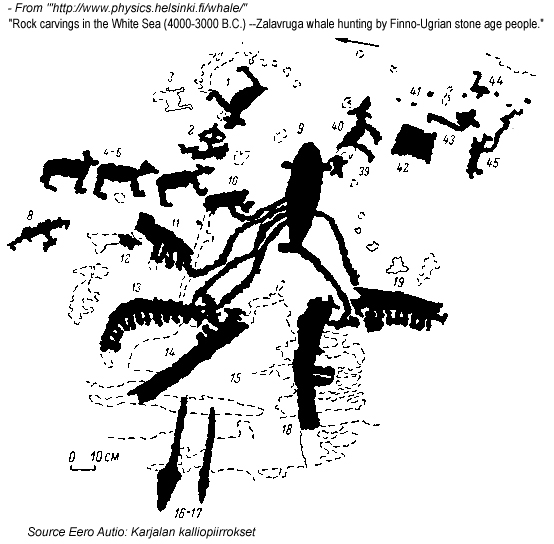
BELOW:
THE WHALE HUNTING ISOLATED FOR CLARITY.......
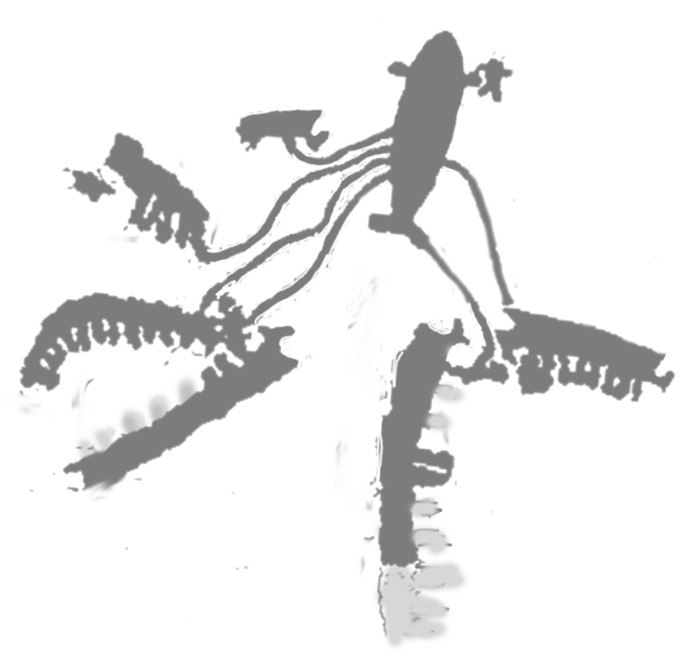
Whale
hunting from moose-skin
boats, probably on the White Sea (in today's arctic Russia,
north of Lake Onega).
(Light grey restores missing, worn, sections) The image would show the entire
tribe, an entire clan per large canoe. It suggests a tribe of 5 clans,
on their annual gathering for carrying out this collective effort.
The above illustration is very surprising, because
it first of all proves that the large boat shown in the Lake Onega rock
carvings in Figure 5, is not some kind of fantasy boat, as early
archeologists said.
It really existed. Note especially the small boats
accompanyng the large one. Apparently - according to North American
Inuit information - when the whale was entrapped, an
individual in a small boat would go to the eye of the whale, get into
the water, and speak
to it, gain its approval and willingness to give up its life.
(Otherwise its spirit would haunt the tribe and bring bad luck - such
making peace with spirits endured also in inland peoples too. The
Algonquian boat peoples of Canada were careful to make peace wih
spirits of deer, moose, bears, etc in hunting activity. The same idea
was found recently in the Hanti (Khanti, Ostyaks) of the Ob RIver of
northwest Siberia. For bears, they went so far as to celebrate the bear
in a wake lasting 4-5 days of celebrations.)
The White Sea illustration does not show
anything imaginary.
It shows the same activity as witnessed in the 18th century and
recorded in the following illustration depicting Greenland whaling..
Figure 8
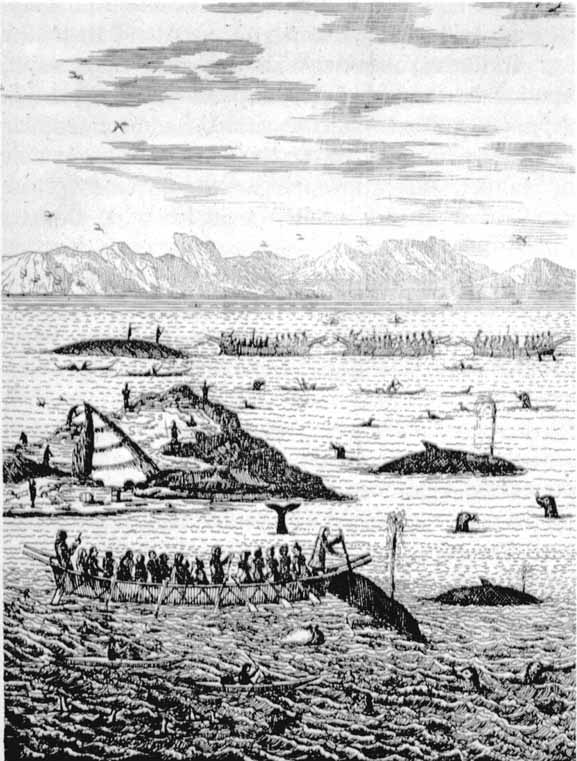
Greenland
'Eskimo' clans meeting to hunt whales
from Description
de histoire naturelle du Groenland, by Hans Egede, tr.
D.R.D.P. Copenhagen and Geneva, Frere Philibert (This image derived
from Canada's
First Nations: A History of Founding Peoples from earliest times
by O. P. Dickason, Toronto, 1992)
The Illustration of the Greenland Inuit shows
only one large boat in
the foreground, but I think that is purely artistic liberty. We see
three more large skin boats in the background, as well as activity on a
rocky island. The artist
sought to show everything in one image. There are a total of four
boats, again suggesting a tribe comprised of four clans. A tribe
consisted of several clans. For most of the year, each clan travelled
by themselves in their own territories, but the clans came together
once a year to carry out activities that were better done collectively.
It happens that whales congregated off the shore of Greenland. While
often nomadic boat people gathered just for social reasons, the
gathering could also be associated with practical purposes which
required teamwork involving all clans pursuing a large collective
purpose. This probably began with reindeer hunting, where the reindeer
moved too fast for humans to follow them, and how all clans had to
gather at a pre-determined place and time to ambush migrating reindeer
as they were migrating north or south.
The lack of a head on the prow of the skin boats in
the more recent illustration means the use of moose skins had long
ended. The end can be identified at the time when a portion of the
people with moosehead prows did not return south to Lake Onega but
began remaining in
the north (the Komsa Culture), The skins of the boats in the
illustration, I would guess, were
made from whale
skins and whales offered no head to celebrate. (Interestingly when
whaling peoples returned to dugout boats on the Pacific coast, they
painted whale eyes on the prow.)
The type of skin boats shown above show
removable skins. The skin appears to be laced onto a frame. A removable
skin then allows it to be used also as a cover for a shelter.
Figure 9
My own idea of how two boat coverng skins could be combined to create
quite a large longhouse. For more on my investigation of this, go
to EXPLAINING LONGHOUSE
"FOUNDATIONS" ON LABRADOR COAST
Sea Hunters of the
North Atlantic
As discussed earlier, aboriginal peoples, whether in the interior or on
the seas, did not
wander aimlessly, but established annual rounds, visiting the same
campsites again and again every year, and each tribe established this
round and the harvesting sites as their 'territory'.
We discussed earlier how interior boat peoples,
settled on river systems, each extended family or clan, assuming one of
the branches of the river as their territory, and then every year all
the clans travelled down the river at an established time and place, to
live for a time all clans together, all the clans of the river forming
a tribe.
Organizing according to rivers was not possible for
seagoing peoples. Since the
boats were mainly paddled and not dependent on wind, the annual
rounds of seagoing clans, would have been defined by ocean currents.
Whale hunting tribal territories would have
developed according to the behaviour of whales and not just ocean
currents (What point are currents if they don't take boats to the
hunting/fishing places!?). Whales migrated up and
down Atlantic coasts, both on the European side and the American
side. Obviously tribes on one side would in the long run diverge
from those on the other side, as a result of reduced contact. When the
whale hunting culture reached the Pacific, it would also have descended
down the Pacific coast, that also has whale migrations. They could have
descended as far south as California, since whales did. If you are a
whale hunter, would you not wonder where they went, and try to follow
them? To hunt animals that migrate north-south, it was not wise to be
situated at either the north and south, but rather in a good middle
location, so that whaling activity could take place twice a year - once
when migrating north, and once when migrating south. The aboriginal
whaling people, ultimately originating from Ice Age reindeer hunters,
already had the wisdom present in their culture. Beside reindeer and
whales, another migrating animal were Atlantic eels. I suspect there
may have been boat peoples who observed regular migrations of Atlantic
eels that travelled long distances and appeared in high concentrations
in channels like between Denmark and Swedish, or the Strait of
Gibraltar, or even the English channel.
Evidence that whale-hunting boat peoples
associated with North America came ultimately from the White Sea
culture, is proven by not just whale hunting traditions - which cannot
be easily acquired when no tradition or wisdom yet exists - but by the
appearance of words that have remarkable parallels in Finnic languages
(today in the regions originally occupied by the "Kunda"
culture.). For example, I found the word for 'harpoon' to be
represented in languages of arctic North America, the northeast Pacific
coast of North America, and in northern Europe (such as in FInnic) We
will explore this in additional supplementary articles with links
presented at the bottom. Compariing words is a highly debated matter,
that is less secure than the hard reality unearthed by archeology.
Actual remnants of the past is always more secure than backward
projection of modern languages.
While whales and the search
for large sea animals in general, like also seals and walrus, may have
been the original reason for boldly venturing into the open sea (quite
scarey until one is used to it), once there, the sea-going hunters also
had access to new places to pursue walrus., seals, and fish, and that
would have caused the
culture to flourish and expand in some places, even without whales.
What evidence can there be found for seagoing
boat peoples that did not pursue whaling?
Alta
Norway, a Major Location that Was a Multi-tribe Meeting Place and
Launching Place for Sea Voyages
THE
TRADITION OF MEETING PLACES
Alta, Norway is a location that must have been
the
meeting place for many tribes - tribes who were indigenous and
harvested the seas, tribes who arrived seasonally from the interior,
and possibly visitors from farther away. The nature practice of
nomadic peoples gathering regularly at established congregating places
was discussed earlier. Not just the gathering of clans that comprised a
tribe, but in loctions accessible by neighbouring tribes, multitribe
gathering sites became established everywhere among the boat peoples,
both seagoing or interior boat peoples.
Evidence that Alta Norway was a multi-tribe
gathering site is evident from the wide variety of images found on its
granite cliffs, not just in terms of subject matter but also artistic
style.
The visitors, finding granite hills engraved with
carvings, would have added their own at every visit. Such places where
many tribes congregate, to trade, exchange news, socialize, and
engage in common festivals are well known throughout the world of
northern hunting peoples.
The Lake
Onega region was one such place where many tribes congregated. The
region at the mouth of the Vistula
another. It is possible to predict such locations according to
the
organization of water systems. Such locations appear in archeological
investigations as different archeological "cultures" overlapping in
that area, suggesting they came together, camped near one another. It
is in such locations that sites of religious/spiritual nature can be
found.
Figure 10
THE ALTA,
NORWAY ROCK CARVING SITE
The Alta area has granite
ridges,
and because granite is
hard, it has
been determined that the carvings are between 6200-2000 years old. This
means it was begun by the earliest skin boat peoples who visited the
warmed waters off the coast - waters warmed by the North Altantic
Drift that reached the arctic Norwegian coast.
But the Alta site continued to recieve tribes both
from along the coast and from the interior, as suggested by the fact
that carvings are as new as 2000 years ago with some examples as late
as 500 years ago. One can argue that a site that starts a tradtion of
rock carvings both attracts more carvings, and in general grows in
importance as a congregating site. The following information box
shows some images from the site (images stolen from the internet)
Figure
11,12,13
The congregating site was
very important to nomadic hunting peoples because they moved around the
environment as clans for most of the year, and needed to meet each
other to share news, find mates, and carry out celedbrations.
It is obvious from
common sense that eventually some
arctic seagoing people would no longer travel south in the winter, this
is clear too from the fact that the Alta carvings show a large number
of skin boats with reindeer, not moose, heads.
But throughout its history the Alta site would have
attracted peoples from the interior, from the Scandinavian interior,
rather than for the Lake Onega area which was considerably further
away. As the map shows Alta was located north of the mountain range and
could be reached from rivers descendng into the interior.
Figure
14
Most of the carvings, from more recent times
generally reflect the historic "Finn" culture in general, which
originally was found in seagoing and forest peoples, and not just the
reindeer herders that have survived into modern times. (The original
word "Finn" became "Lapps" and as later as the early 20th century,
there were "Forest Lapps" and "Fisher Lapps" as well as the "Reindeer
Lapps". Today the word they prefer is "Saami")
It is easy to see why. when the Germanic Norway was
created, the regions to the interior was called "Finnmark". Towards the
east there was "Finnlanda" which became today's Finland. It underscores
the fact that the "Finns",
were the indigenous peoples, But there has been debate as to how
they relate to the Finnish who cover the same landscape in the form of
today's Finland. An obvious answer it that they are almost the same,
since when Finland became a country there was no sharp distinction
between the natives in the wilderness and the "Finns" in the more
developed southern Finlands. The Finns could ultimately be descended
from the "Kunda" culture, with some additional mongoloid genes from
Asian reindeer peoples who came from the east - as discussed elsewhere.
In my thinking, Finnic languages like Finnish and Estonian, are
descended from the "Kunda" archeological culture, and that there was no
new language from the east. I believe this because of my ability to
find numerous word-coincidences between Finnic and seagoing boat
peoples, especially whalers.
Expansions of the Seagoing Skin-Boat People into the
North Atlantic
READING
THE EVIDENCE IN ARCTIC SCANDINAVIA
The rock carvings found at Alta
Norway tell a story
about people who were there
to harvest the rich sea life off the arctic coast of Norway, where the
warm waters of the Atlantic Drift (originating as the Gulf Steam on the
American coast) ended up. As I mentioned above, the peoples of the
moosehead skin boats originally made annual journeys all the way from
Lake Onega where rock carvings there show images of such boats.
Originally visitors to the warmed arctic seas would have headed south
in fall, to avoid the dark winter. The Lake Onega rock carvings show
images of moose, but none showing them with antlers. Males grow their
antlers in summer and lose them in fall, thus these people were away
when the moose had antlers.
But the journey was a long one, taling several
weeks, and eventually a tribe stayed through the dark winter.
Archeology has found such a winter settlement, and called it the
"Komsa" archeological culture at the top of
Norway at the mouth of the Teno River.
The Alta carvings also suggest there were people there too,
perhaps later, who
stayed, because of the many images of boats with reindeer heads on the
prows, not moose heads.
The many rock carvings of skin boats, and the
hunting of seals and whales prove that the descendants of the Kunda
culture were at the White Sea, islands of arctic Norway, and in the
vicinity of Alta, Norway.
Studying the geography of the North Atlantic, we can
logically predict that seagoing boat people
could have formed three tribes, one for each possible circuit of moving
with currents..See the map of Figure 9.. While certainly these
people could have improvised sails to catch the wind, they travelled
mostly by paddling with currents.
The map below, shows
the currents of the North Atlantic and how we are able to identify
three 'territories' - A, B, C.
Figure
17
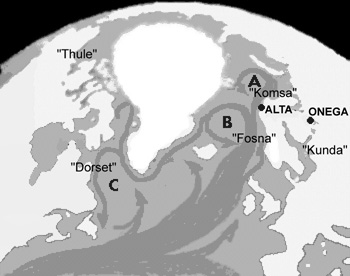
Map shows ocean currents
of the North
Atlantic and some of the names mentioned in this text. The names in
quotes represent archeological "cultures". ALTA and ONEGA name two
major locations of rock carvings showing boats, dating to 6000 years
ago. The letters A, B, C show areas where currents loop around. Since
early boats were not particularly wind-driven, they would have been
oriented to currents, and each of these loops could have defined a
tribe undertaking migrations that may have lasted many years before
returning to the same place.
How can we detect such long distance oceaning
migrations of boat peoples ultimately originating in the
archeologically defined "Kunda" (or "Maglemose"?) culture? One way
would be to look at language, to
see if it shows a trail of the same words. For example, can we find the
same word for 'harpoon' or 'water' or 'sea' words that are likely to
continue to be used up to the modern day? But the easiest
detected indication of the migration of a northern European seagoing
boat people culture
is the skin boat, particularly if it kept the tradition of the
animal head on the prow. When the purpose of it was forgotten,. it may
have become fantastic, and become the so called 'dragon boat'. Can we
trace the 'dragon boat' of the Norse back to the moosehead skin boat?
Probably yes, since the Norse included the native cultures of the
Norwegian coast. Can we trace the 'dragon boat' to the ancestors
of the Ainu native peoples of Japan? That is more difficult; however
the word Ainu resonates with "Inuit" and other arctic aboriginal
peoples. The modern Ainu, however show considerable historic mixing, so
it is impossible to come to any conclusion. It however is certainly
possible that if the whaling people reached the North American arctic
and Pacific coast, they could have also migrated south along the Asian
coast.
The head on the prow of a vessel
is a
phenomenon that has endured down through time, and its last
manifestation has been the hood ornament on the modern automobile or
truck, particularly if the ornament represents an animal. In culture we
do such things, and we do not know why; but some customs can have roots
that are many thousands of years old.
Whale-hunting traditions have
endured on the Pacific coast, particularly in Native peoples of the
region around Vancouver Island and to its south.(Peoples of the
"Wakashan" languages) There, memories of whaling are still strong, and
attempts are being made to recover the culture. If you look at the
graphics painted on the large dugouts of the Pacific coast, you will
see eyes painted on the front. If asked, the artist may say it is to
help guide the way, but it may tell a deeper story of a long tradition
of honouring the spirit of the animal from which the skin came.
They may have
arrived in skin boats made of whale skin, with the whale head
represented by painting its eyes at the front. Because of the giant
cedar trees of the Pacific coast, whaling peoples arriving there were
able to return to the creation of seagoing dugouts. Converting to the
cedar
dugout, they continued to paint the eyes at the front. It had to have
occurred this way, because such a practice of representing the head of
an animal at the front has never existed in the dugout boat tradition.
The coincidence between Pacific coast seagoing dugouts having an eye
painted on the front, and the whaling traditions cannot be assigned to
random chance!!
SOURCES
AND REFERENCES
Since this webpage has been
constantly updated - edited and changed - many sources and references
are
acknowledged where possible in the text or beside the picture. If a
statement is made or picture shown, without a source, that means the
image is either fully original by the author (A.Paabo)or significantly
modified artistically.
Clark, G, 1967 World Prehistory,
Cambridge A celebrated text that
summarized the accumulated archeological discoveries up to that time.
Since then the ideas have simply been refined.
Jaanits, L. et al, 1982, Eesti
Esiakalugu, Eesti Raamat, Tallinn In
Estonian, the product of Estonian archeological work during the Soviet
period, where the authors were able to access the work of other
archeology within the Soviet Union, not as accessible in the west.
Kozlowski J, and Bandi H-G 1984 The
Paleohistory of Circumpolar
Arctic Colonizationm, Arctic 37 (4): 359-372 Article in English,
where
the investigation of the northeast Europe and the Urals was only one
section. I chose to use it for reference because of this focus, and
because it was a summary.
Rootsi,S., et al. 2006, A
counterclockwise northern route of the Y-chromosome haplogroup N from
Southeast Asia towards Europe”
European Journal of Human Genetics 15 (2): 204-11 Comment: This
is regarded as the authorative study suggesting the N1c1 haplogroup
migrated up the Ural Mountains and then continued west along the arctic
coast of northeast Europe to the northern Finland area, and then
diffused into the Finno-Ugric speakers from the locations of the
reindeer peoples. .
author: A.Paabo, Box 478,
Apsley, Ont., Canada
2013 (c) A. Pääbo.
 <<< CONTENTS
<<< CONTENTS

